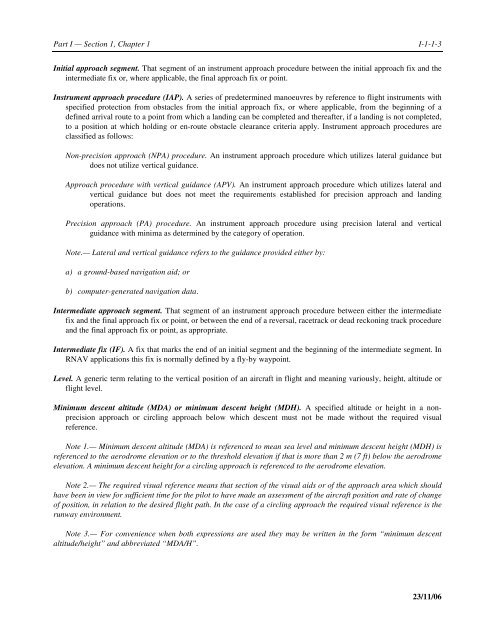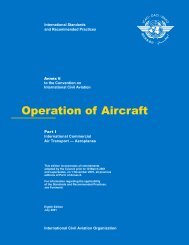Aircraft Operations
Doc 8168 Aircraft Operations, Volume I Flight Procedures
Doc 8168 Aircraft Operations, Volume I Flight Procedures
- No tags were found...
Create successful ePaper yourself
Turn your PDF publications into a flip-book with our unique Google optimized e-Paper software.
Part I — Section 1, Chapter 1<br />
I-1-1-3<br />
Initial approach segment. That segment of an instrument approach procedure between the initial approach fix and the<br />
intermediate fix or, where applicable, the final approach fix or point.<br />
Instrument approach procedure (IAP). A series of predetermined manoeuvres by reference to flight instruments with<br />
specified protection from obstacles from the initial approach fix, or where applicable, from the beginning of a<br />
defined arrival route to a point from which a landing can be completed and thereafter, if a landing is not completed,<br />
to a position at which holding or en-route obstacle clearance criteria apply. Instrument approach procedures are<br />
classified as follows:<br />
Non-precision approach (NPA) procedure. An instrument approach procedure which utilizes lateral guidance but<br />
does not utilize vertical guidance.<br />
Approach procedure with vertical guidance (APV). An instrument approach procedure which utilizes lateral and<br />
vertical guidance but does not meet the requirements established for precision approach and landing<br />
operations.<br />
Precision approach (PA) procedure. An instrument approach procedure using precision lateral and vertical<br />
guidance with minima as determined by the category of operation.<br />
Note.— Lateral and vertical guidance refers to the guidance provided either by:<br />
a) a ground-based navigation aid; or<br />
b) computer-generated navigation data.<br />
Intermediate approach segment. That segment of an instrument approach procedure between either the intermediate<br />
fix and the final approach fix or point, or between the end of a reversal, racetrack or dead reckoning track procedure<br />
and the final approach fix or point, as appropriate.<br />
Intermediate fix (IF). A fix that marks the end of an initial segment and the beginning of the intermediate segment. In<br />
RNAV applications this fix is normally defined by a fly-by waypoint.<br />
Level. A generic term relating to the vertical position of an aircraft in flight and meaning variously, height, altitude or<br />
flight level.<br />
Minimum descent altitude (MDA) or minimum descent height (MDH). A specified altitude or height in a nonprecision<br />
approach or circling approach below which descent must not be made without the required visual<br />
reference.<br />
Note 1.— Minimum descent altitude (MDA) is referenced to mean sea level and minimum descent height (MDH) is<br />
referenced to the aerodrome elevation or to the threshold elevation if that is more than 2 m (7 ft) below the aerodrome<br />
elevation. A minimum descent height for a circling approach is referenced to the aerodrome elevation.<br />
Note 2.— The required visual reference means that section of the visual aids or of the approach area which should<br />
have been in view for sufficient time for the pilot to have made an assessment of the aircraft position and rate of change<br />
of position, in relation to the desired flight path. In the case of a circling approach the required visual reference is the<br />
runway environment.<br />
Note 3.— For convenience when both expressions are used they may be written in the form “minimum descent<br />
altitude/height” and abbreviated “MDA/H”.<br />
23/11/06












